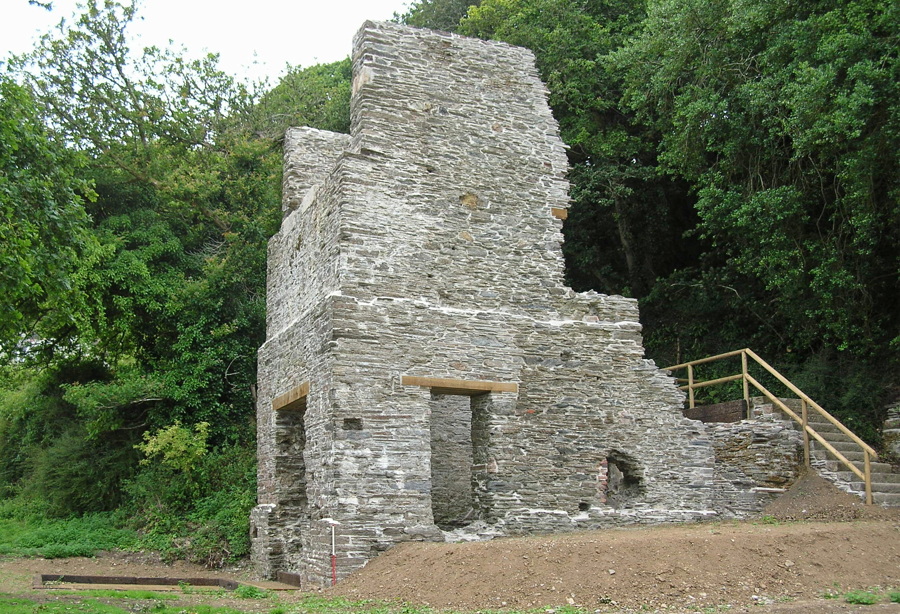(2010) Theatre and song at South Hooe Mine
Mining in the area of South Hooe on the Bere Alston peninsula is of considerable antiquity. Records indicate that mining for silver-lead was being undertaken here by the first quarter of the fourteenth century and operations are known to have continued in some form until the end of the fifteenth, by which time the most readily accessible ores had presumably been removed. The lodes were being exploited again by the end of the eighteenth century however when improvements in mine pumping, using steam technology, enabled the mineworkers to reach much greater depths. A 20-inch cylinder Boulton & Watt beam engine is recorded in use by 1788.
‘New South Hooe Mine’ is first recorded as a company in 1836 at around which time a 50-inch cylinder Cornish pumping engine was installed to dewater the workings which were extending out under the River Tamar. Over forty years of productive working followed until the early 1880s when the site was abandoned to nature following a brief working for fluorspar, for use in glass making. Being in a rather remote location on a bend in the river, South Hooe is not a site many have stumbled across and is certainly one of the less familiar parts of the World Heritage Site.
The abandoned engine house was to remain in a state of advancing decay until 2010 when the opportunity of applying European Union funding for conservation, through the Natural England Higher-Level Stewardship (HLS) scheme, was made known to the site owner. Discussions with Natural England officers, a Cornwall Council archaeologist, and the owner fortunately resulted in an agreement being made which would deliver the funds required for the work. Following archaeological and ecological surveys of the site, and after formulating an appropriate consolidation plan, building work commenced. Darrock & Brown were the contractors undertaking the task, which was delivered, without a hitch, within the ten weeks agreed for the contract.
Part of the HLS agreement was the requirement for improved public access to the site and to this end a programme of four free open days per year are scheduled for each of the ten years of the scheme overall. The first of these was held on 13th June when this once rich silver-lead mine became the backdrop for a day of theatre, stories and music.
The audience, a mixture of locals and those from further afield, were greeted by the eager smiling faces of 6th form students from Millfield School and were then taken off into the adjoining woods where the medieval sound of ‘Occupants of the Hedge’ serenaded their journey down to the mine. As they made their way beneath the canopy of trees, poems and stories and little quotes hung from every branch, so the way was slow as eager eyes soaked up the words of wisdom. Lucky younger members of the audience may have come across a rabbit spotter in the woods and, if they were very quiet and very patient, a Lesser Spotted Giant Rabbit may have come out to play! On emerging from the wood, the Celtic sound of ‘Dalla’ was wafting down the Tamar Valley. The four-strong Cornish band played on the beautiful stage right above the site of the pumping shaft used during the working days of the mine. As Cornish pasties and elderflower cordial refreshed and nourished the guests the main programme of events began to unfold.
With the backdrop of the engine house, a 40 strong cast of GCSE students performed ‘Brokenville’, a heart-warming tale of the power of storytelling. The live haunting violin playing from one young boy set the tone of the play. Bec Applebee then performed her incredibly brave and absorbing one woman show covering the story of the Cornish highwaywoman Mary Bryant. This intense piece performed on the edge of the Tamar in this way was spell bindingly beautiful and a fantastic way to celebrate the rebirth of an engine house so steeped in history.
The day was also interspersed with snippets of story from Clive Fairweather and little gems of traditional Cornish piping from Dave Hart as well as some impromptu performances from the ‘Tavy Tarrs’ playing songs such as Cousin Jack, a tribute to the miners of Devon and Cornwall. All in all, it was a glorious day of sunshine, music, theatre and stories celebrating the beautifully restored engine house, one of only a few which survive in the west Devon area of the World Heritage Site.
Daisy Dugmore, 2010
